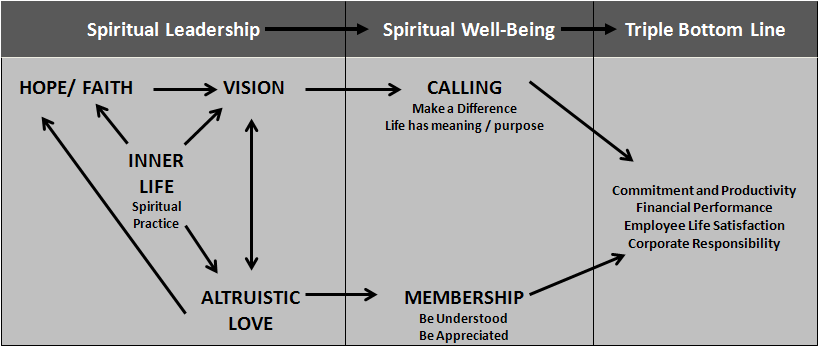Spiritual leadership is an emerging paradigm within the broader context of workplace spirituality designed to create an intrinsically motivated, learning organization. Spiritual leadership comprises the values, attitudes, and behaviors necessary to intrinsically motivate one’s self and satisfy fundamental needs for spiritual well-being through calling and membership, which positively influences employee well-being, sustainability and corporate social responsibility, and financial performance – the Triple Bottom Line.
Essential to spiritual leadership is:
- Creating a vision wherein leaders and followers experience a sense of calling so that their lives have purpose, meaning and makes a difference, and
- Establishing a organizational culture based on the values of altruistic love whereby leaders and followers have a sense of membership, feel understood and appreciated, and have genuine care, concern, and appreciation for BOTH self and others.
As shown in the figure below, the source of spiritual leadership is an inner life or spiritual practice, such as spending time in nature, prayer, religious practice, meditation, reading, yoga, or writing in a journal. An inner life practice positively influences spiritual leadership through the development of hope and faith in a transcendent vision of service to key stakeholders that keeps followers looking forward to the future. Hope/faith in a clear, compelling vision produces a sense of calling – that part of spiritual well-being that gives one a sense of making a difference and, therefore, that one’s life has meaning. Spiritual leadership also requires that the organization’s culture be based on the values of altruistic love. Leaders must model these values through their attitudes and behavior, which creates a sense of membership – that part of spiritual well-being that gives one a sense of being understood and appreciated. The dimensions of spiritual leadership and the process of satisfying spiritual needs then positively influence the key individual and organizational outcomes that comprise the Triple Bottom Line.
The Organizational Spiritual Leadership Model
Personal vs. Organizational Spiritual Leadership
An important distinction we make in spiritual leadership is between leading (personal spiritual leadership) and leadership (organizational spiritual leadership). Leading is concerned with leader development of personal spiritual leadership (PSL) where the emphasis is typically on individual knowledge, and skills and abilities associated with a formal leadership role, as well as the directional influence of leaders on followers.
Leadership is concerned with organizational spiritual leadership development (OSL) where the focus is on the collective social influence process that engages everyone and enables groups of people to work together in meaningful ways. Organizational Spiritual Leadership emphasizes a less leader-centric approach, focusing on engaging all group members to meet spiritual needs and enhance organizational commitment and performance. In this way, each person exercising positive influence enhancing the group’s calling, membership, and performance is considered a leader. Spiritual leadership is thus both a cause and effect as group members interact and various formal and informal leaders in the group emerge.
The Components of the Spiritual Leadership Model
Spiritual leadership, with inner life as its source, emerges from the interaction of, hope/faith, vision, and altruistic love. The qualities of Spiritual Leadership are shown in Table 2.
Table 2: The Qualities of Spiritual Leadership
Vision
- Broad Appeal to Key Stakeholders
- Defines the Destination and Journey
- Reflects High Ideals
- Encourages Hope/Faith
- Establishes Standard of Excellence
Altruistic Love
- Trust/Loyalty
- Forgiveness/Acceptance/ Gratitude
- Integrity
- Honesty
- Courage
- Humility
- Kindness
- Compassion
- Patience/Meekness/Endurance
- Excellence
- Fun
Hope/Faith
- Endurance
- Perseverance
- Do What it Takes
- Stretch Goals
- Expectation of reward/victory
- Excellence
Inner Life
An inner life or spiritual practice is important in the process of enabling personal spiritual leadership and facilitating work that is meaningful and takes place in the context of a community. Many companies are beginning to recognize the importance of supporting an employees’ inner life. Cordon Bleu-Tomasso Corporation has established a room for inner silence. Australia and New Zealand Banking Group Ltd’s (ANZ) have developed training programs focusing on “High Performance” mind techniques and “quiet rooms” for individual spiritual practice. Missouri’s Ascension Health is committed to a workplace that deepens personal spirituality through the adoption of an ethical discernment process that fosters self-reflection. These organizations and many others recognize that employees have spiritual needs (i.e., an inner life) just as they have physical, mental, and emotional needs, and none of these needs are left at the door when they arrive at work.
Spiritual Leadership
Hope/Faith. Hope is a desire with expectation of fulfillment. Faith adds certainty to hope. Taken together, Hope/Faith is a firm belief in something for which there is no evidence. It is based on values, attitudes, and behaviors that demonstrate absolute certainty and trust that what is desired and expected will come to pass. Individuals with Hope/Faith have a vision of where they are going, and how to get there. They are willing to face opposition and endure hardships and suffering in order to achieve their goals. Hope/Faith is also the source for the conviction that the vision, either personal or organizational, will be fulfilled. In action Hope/Faith is like a race that has two essential components–the victory (vision) and the joy preparing for the race itself. Both components are necessary and essential elements of Hope/Faith to generate the necessary effort to pursue the vision.
Vision. Vision refers to a picture of the future with some implicit or explicit commentary on why people should strive to create that future. Tomasso Corporation’s vision of “Joyful and Passionate People Serving Enthusiastic Customers is an example. In motivating change, vision serves three important functions by clarifying the general direction of change, simplifying hundreds or thousands of more detailed decisions, and helping to quickly and efficiently coordinate the actions of group members. Moreover, a compelling vision energizes workers, gives meaning to work, and garners commitment, and establishes a standard of excellence. In mobilizing people a vision must have broad appeal, define the organizations destination and journey, reflect high ideals, and encourage hope and faith.
Altruistic Love. For spiritual leadership, altruistic love is defined as a sense of wholeness, harmony, and well-being produced through care, concern, and appreciation for both self and others. There are great emotional and psychological benefits from separating love, or care and concern for others, from need, which is the essence of giving and receiving unconditionally. Both medicine and the field of positive psychology have begun to study and confirm that love has the power to overcome the negative influence of destructive emotions such as resentment, anger, worry, and fear. Altruistic love defines the set of key values, assumptions, understandings and ways of thinking considered to be morally right that are shared by group members and taught to new members (See Table 1). Spiritual leaders embody and abide in these values through their everyday attitudes and behavior. (Keep reading for more on the values of altruistic love.)
Spiritual Well-Being
Calling. Calling refers to the experience of transcendence or how one makes a difference through service to others and, in doing so, finds meaning and purpose in life. Many people seek not only competence and mastery to realize their full potential through their work but also a sense that work has some social meaning or value. The term calling has long been used as one of the defining characteristics of a professional. Professionals in general have expertise in a specialized body of knowledge, ethics centered on selfless service to clients/customers, an obligation to maintain quality standards within the profession, a commitment or calling to their vocational field, a dedication to their work, and a strong commitment to their careers. They believe their chosen profession is valuable, even essential to society, and they are proud to be a member of it. The challenge for organizational leaders, which is addressed through the spiritual leadership model, is how to develop this same sense of calling in its workers through task involvement and goal identification.
Membership. Membership encompasses a sense of belonging and community; The cultural and social structures we are immersed in and through which we seek, what William James, the founder of modern psychology called man’s most fundamental need – to be understood and appreciated. Having a sense of being understood and appreciated is largely a matter of interrelationships and connection through social interaction and thus membership. At work, people value their affiliations and being interconnected to feel part of a larger community. As we devote ourselves to social groups, membership extends the meaning of our personality by enmeshing it in a network of social connections that goes out as far as the group has influence and power, and backwards and forwards in relations to its history. Ultimately, we grow greater, longer lived, more meaningful in proportion as we identify ourselves with the larger social life that surrounds us.

